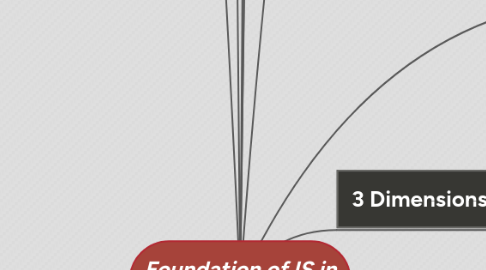
1. Business
1.1. Business strategic objective process
2. IT
2.1. software
2.1.1. hardware
2.1.2. data management
2.1.3. telecommunication
3. Perspective on IS
3.1. collect , process , store ,distribute onformation
3.2. support decision making , coordination and control
3.3. set of interrelated components
3.4. BUSINESS PERSPECTIVE ON IS
3.4.1. IS = instrument for creating value
3.4.1.1. Productuvity process
3.4.1.2. Revenue increase
3.4.1.3. superior long term strategic positioning
3.4.2. 3 ways that IS can add value
3.4.2.1. help managers make better decisions
3.4.2.2. help make business more efficient
3.4.2.3. increase profitability
3.4.3. From the graph (phone) we want to be in Q1 ,2 because go high productivities whether with or without IT ( Not every IT succesful)
4. DATA SHAPED= INFORMATION
5. 3 activities of IS produce information organisations need
5.1. Input
5.2. processing
5.3. output
5.4. output
6. Input
6.1. Regulatory Agencies
6.2. suppliers
7. Processing classify Arrange Calculate
7.1. Feedback
7.1.1. stock holder
8. Output
8.1. competitors
8.2. customers
9. Technology investment
9.1. Investment in IT
9.1.1. not guarantee returns
9.2. considerable variation in returns firms receive from system investments
9.3. FACTORS
9.3.1. Adopting right business model
9.3.2. Investing in complementary assets
9.3.2.1. Organizational asset
9.3.2.2. managerial asset
9.3.2.3. social assest
10. Contemporary Approach to IS
10.1. Management IS
10.1.1. Combines computer science, management science , operation research and practical orientation with behavioural issue
10.2. 4 ACTORS
10.2.1. SUPPLIERS of software / hardware
10.2.2. Firms
10.2.3. managers and employees
10.2.4. Firms' environment
11. Problems
11.1. digital divide
11.1.1. Gap between one who has and doesn't have technology
11.1.2. indicators
11.1.2.1. Infrastructure
11.1.2.1.1. Internet access cost
11.1.2.1.2. level of education
11.1.2.1.3. Income , gender
11.1.2.1.4. Ethnicity
11.1.2.1.5. others
11.1.2.2. Socioeconomics enables
11.1.2.2.1. ICT (information and communications technology) penetration infrastructure
11.1.2.2.2. Numbers of Internet users
11.1.2.2.3. mobile density
11.1.2.2.4. broadband system
11.1.2.3. CLOSE THE GAP
11.1.2.3.1. economics growth
11.1.2.3.2. social mobility
12. evolution
12.1. agricutural age
12.1.1. pre 1800
12.1.2. farmers
12.1.3. People- land
12.1.4. handtools
12.2. Industrial age
12.2.1. 1800-1950
12.2.2. factory workers
12.2.3. people-machine
12.2.4. machine
12.3. Information age
12.3.1. 1950-now
12.3.2. knowledge worker
12.3.2.1. creation
12.3.2.2. distribution
12.3.2.3. Application Information
12.3.3. people-peolple
12.3.4. IT
13. Rules of IT in Business
13.1. operational excellence
13.1.1. Improvement of efficiency to attain higher profitability
13.1.2. IS , technology =important tool in accheiving greater efficiency and productivity
13.2. New products, Business model
13.2.1. BUSINESS MODEL = how many produces,delivers ,sells products or services
13.2.2. IS & Technology= a major enabling tools for new products , services , business models
13.3. Customer and Supplier intimacy
13.3.1. Serving customers well leads to customers returning
13.3.2. Intimacy with supplier allows them to provide vital inputs which lower cost
13.4. Improved decision making
13.4.1. without accurate information
13.4.1.1. managers must use forecasts ,best guesses,luck
13.4.1.1.1. over or under production
13.4.1.1.2. misallocation
13.4.1.2. poor outcomes raise costs, lose customers
13.5. compettitive advantage
13.5.1. lead to higher sales and profits
13.5.2. delivering better performance
13.5.3. charging less for superior products
13.5.4. responding to customers ans suppliers in REAL-TIME
13.6. Survival
13.6.1. Information technologies as necessity of business
13.6.2. Industry-level changes
13.6.2.1. eg CITI Bank-----> ATM
13.6.3. Governmental regulations requireing record -keeping
14. make possible due to DIGITAL, MOBILE , NETWORK technology catagorized by
14.1. Innovation
14.2. Increased important on information
14.3. Globalization
14.4. Network economics + societies
15. How IS transform Business
15.1. Increase in wireless technology
15.2. website
15.3. web 2.0( Blog, Social media)
16. Globalization opportunity
17. In the emerging ,fully digital firm
18. Digital firms offer greater flexibility
18.1. eg. time & space shifting
19. ex. Walmart
19.1. Reatil link system
19.2. distribution
19.3. warehouse
20. 3 Dimensions of IS
20.1. Technololgy
20.1.1. computer hardware / software
20.1.2. data management technology
20.1.3. networking and telecommunications technology
20.1.4. IT infrastructure
20.2. Organization
20.2.1. Hierarchy of Authority , Responsibility
20.2.2. separation of business functions
20.2.3. unique business process
20.2.4. unique business culture
20.2.5. organisational politics
20.3. Management
20.3.1. Manager set organisational strategy for responding to business challenge
20.3.2. managers must act creatively

